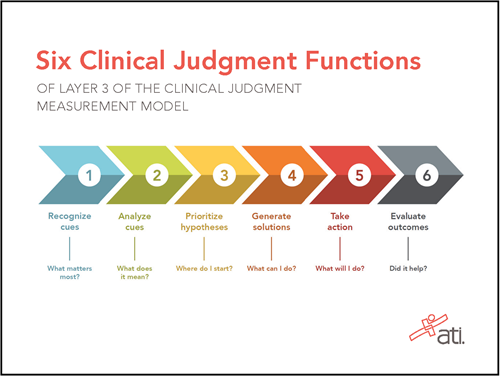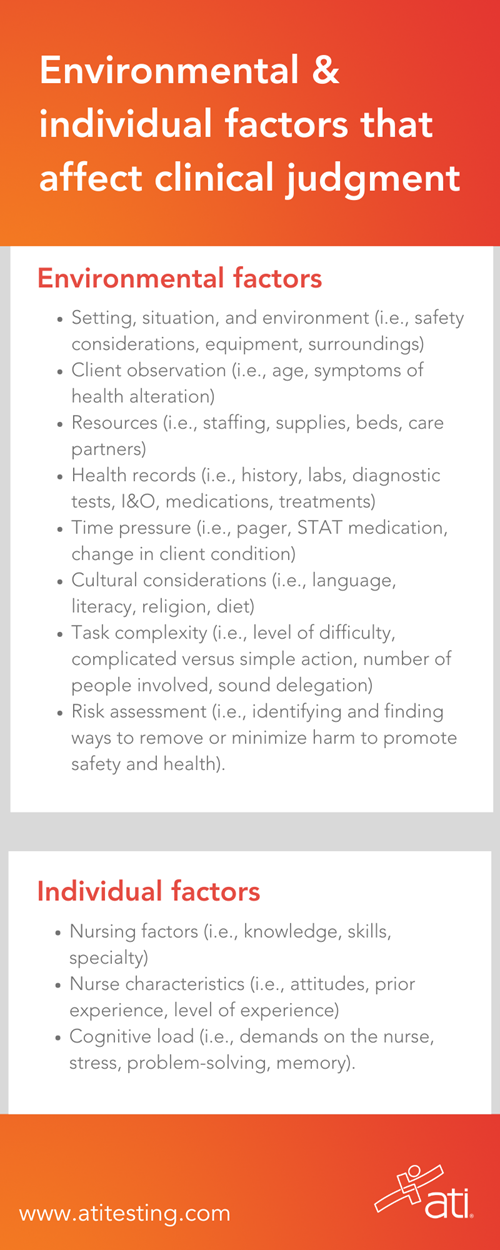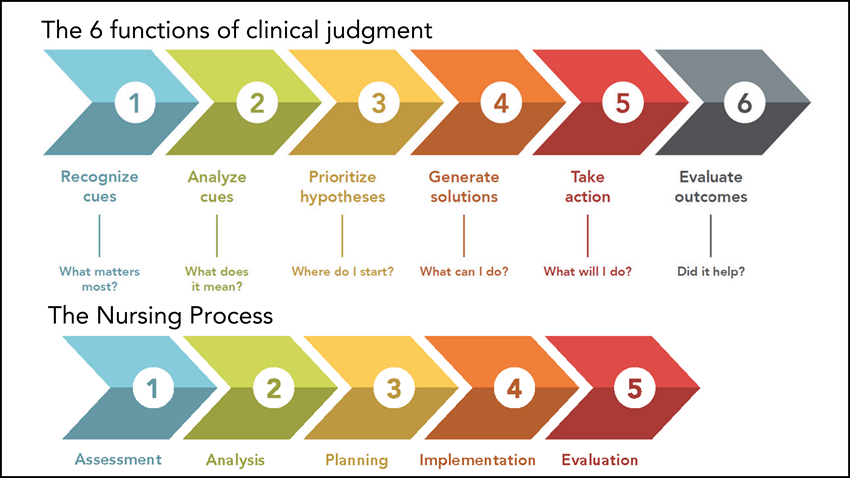What are the NCSBN’s 6 functions of clinical judgment for NGN?
Here’s a helpful Next Gen NCLEX graphic to remind you about clinical judgment
Looking for guidance on teaching clinical judgment? Click here to read an article that outlines specific strategies.
To help nurse educators better understand the nuances of the new version of the NCLEX (referred to as the Next Generation NCLEX [NGN]), the National Council of State Boards of Nursing (NCSBN) created a Clinical Judgment Measurement Model (NCJMM). Its purpose is to help nurse educators and clinicians evaluate candidates’ clinical judgment. The model identifies the functions in the cognitive process that a nurse employs during decision-making — functions that align closely with the Nursing Process.
These 6 steps involve a repetitious process the nurse moves through when interacting with every client. The process is iterative, meaning the nurse can gain new information or cues while assessing or treating the client. The new information can cause the nurse to return to a previous function and then move through the process again, continuously re-evaluating.
STAY UP-TO-DATE ON THE NEXT GENERATION NCLEX
 The 6 cognitive functions are:
The 6 cognitive functions are:
- Function 1: Recognize cues (assessment). The filtering of information from different sources (i.e., signs, symptoms, health history, environment).
- Function 2: Analyze cues (analysis). The linking of recognized cues to the client's clinical presentation and establishing probable client needs, concerns, and problems.
DOWNLOAD THE GRAPHIC AT RIGHT AS A HANDY REFERENCE
- Function 3: Prioritize hypotheses (analysis). Establishing priorities of care based on the client's health problems (i.e., environmental factors, risk assessment, urgency, signs/symptoms, diagnostic tests, lab values).
- Function 4: Generate solutions (planning). Identifying expected outcomes and related nursing interventions to ensure a client’s needs are met.
- Function 5: Take actions (implementation). To implement appropriate interventions based on nursing knowledge, priorities of care, and planned outcomes to promote, maintain, or restore a client's health.
- Function 6: Evaluate outcomes (evaluation). To evaluate a client's response to nursing interventions and reach a nursing judgment regarding the extent to which outcomes have been met.
THE NCLEX (NEXT GEN NCLEX) INCLUDES ITEMS ABOUT OTHER FACTORS THAT IMPACT CLINICAL JUDGMENT
To help nursing students understand the aspects of their job that affect their clinical judgment, the NCSBN identified additional factors — environmental and individual — that impact the clinical situation. Students must also consider these factors to ensure they make an appropriate clinical decision.

The Next Gen NCLEX incorporates environmental and individual factors into items on the exam as it attempts to assess students’ clinical judgment. That means you should keep these factors in mind when you develop lessons. Doing so will build students' clinical judgment and ensure they are practice-ready as they face the NGN and officially enter their new profession.
Examples of the factors include:ENVIRONMENTAL
- Setting, situation, and environment (i.e., safety considerations, equipment, surroundings)
- Client observation (i.e., age, symptoms of health alteration)
- Resources (i.e., staffing, supplies, beds, care partners)
- Health records (i.e., history, labs, diagnostic tests, I&O, medications, treatments)
- Time pressure (i.e., pager, STAT medication, change in client condition)
- Cultural considerations (i.e., language, literacy, religion, diet)
- Task complexity (i.e., level of difficulty, complicated versus simple action, number of people involved, sound delegation)
- Risk assessment (i.e., identifying and finding ways to remove or minimize harm to promote safety and health).
DOWNLOAD THE INFOGRAPHIC AT RIGHT AS A HANDY REFERENCE
INDIVIDUAL
- Nursing factors (i.e., knowledge, skills, specialty)
- Nurse characteristics (i.e., attitudes, prior experience, level of experience)
- Cognitive load (i.e., demands on the nurse, stress, problem-solving, memory).
To prepare your students for the NCLEX and build their clinical judgment skills, reiterate these 3 simple steps as often as possible:
- Show them how these cognitive functions interact.
- Point out the relationship between the Nursing Process and clinical judgment.
- Explain how they work in tandem to help nurses deal with complex clinical situations.
With each reminder, students will be better prepared for the exam and for becoming practice-ready nurses.


